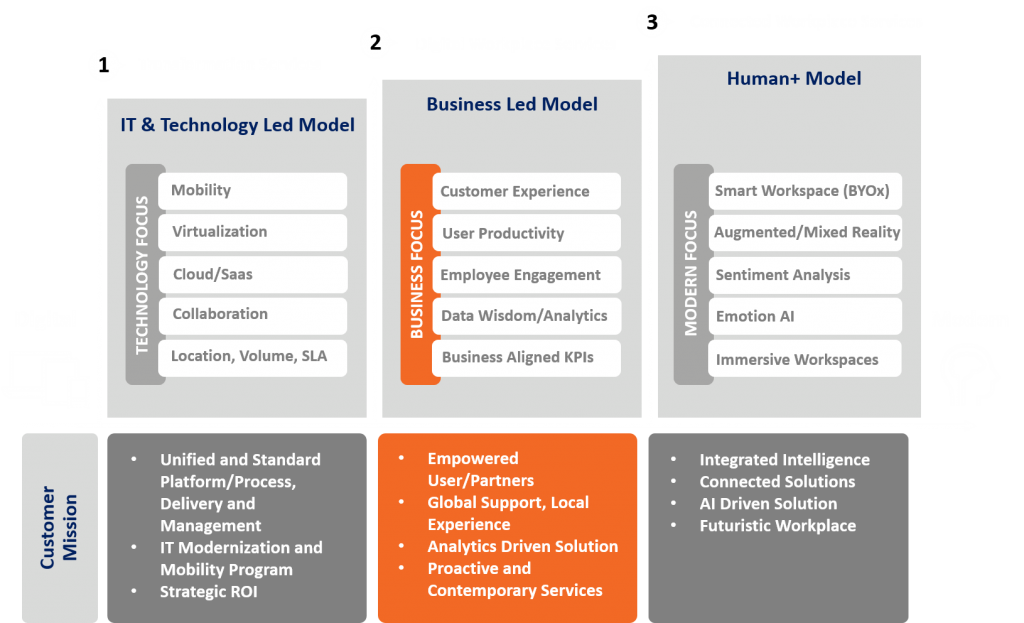
Empowering the enterprise workforce – 4
Read time: 4-5 Mins
Read blog 3 of this series to know Critical Success Factors For Building A Digitally Mature Workplace.
Evolving technology and changing employee expectations call for a new work environment – one that enables a seamless flow of information across personal and professional spaces to break down communication barriers and foster growth, efficiency, and innovation. However, the effective implementation of any digital workplace strategy requires thorough identification of existing challenges. Additionally, the success of your digital workplace solution (DWS) also depends on your vendor. In this case, the level of customization and training to get you started, as well as ongoing support to keep your systems updated and running optimally, are a few contributing factors.
Zensar has developed a flexible and customized solution model for Digital Workplace Solutions built around specific customer needs, existing IT architecture, and level of technology investment.
The digital transformation journey is envisioned as a two-step process to transform an enterprise from an IT led model to a business led model. Rather than using a technology-led model, the focus is on human+services to create an agile technology framework focused on customer experience, user productivity, employee engagement, and business impact.

The process starts with a Digital Maturity Assessment to gauge an organization’s digital maturity level, identify the gaps between user experience and employee productivity and build a digital roadmap that optimizes technology investment and ROI. Basis the assessment, tailored digital workplace solutions are built to cater to the business, users, and IT needs.
For example, all industries have operational requirements and KPIs. With customized DWS, it becomes possible to use industry-specific metrics for measuring productivity and optimizing processes accordingly.
Besides meeting business requirements, it is essential to focus on employee engagement and experience. As you’d possibly agree, human resource is the most important resource in Industry 4.0. Therefore, it is essential to build a workplace around the end users’, that is, employees’ requirements. Additionally, changing user personas in terms of business transformation demand an agile system that can be scaled on-demand. Furthermore, a robust IT environment is the key to digital transformation. However, it should not be overly complicated, or users will not benefit from it. Thus, apart from investing in technology, it is also important to keep an eye on the business and user impact of technology adoption. This helps in fine-tuning the strategy and improve ROI in the fastest and most controlled way.
Zensar’s Transformation Journey
Change begins at home. To start with, we demonstrated the efficiency of our DWS by transforming our internal workflows. One wide-reaching change was introducing a talent management app that uses a chatbot and matching engines to help employees find suitable roles within the organization.
The all-new employee engagement platform digitizes touchpoints across the employee lifecycle, from onboarding to performance and leave management, to increase transparency and satisfaction. Automation of employee service desk using a chatbot has also streamlined grievance redressal, closing up to 300 requests monthly for providing admin rights without human intervention. Besides, service desk automation has helped improve the turnaround time and optimize engineers’ workloads for critical tasks.
The Business Impact of Digital Transformation
At Zensar, we successfully improved employee productivity and engagement through customized digital transformation solutions. Following a similar strategy, we upgraded the legacy systems for a leading pharma company headquartered in the US. By deploying next-gen collaborative tools such as O365, Skype for business, and enterprise mobility solutions, we ensured a consistent workforce experience with seamless information flow while future-proofing the enterprise against potential disruptions. The solution delivered a reduction in TCO of more than 30% and enabled the customer to achieve a 98% CSAT across all service levels and KPIs.
We also partnered with a global financial advisory firm to provide a DWS that reduced operational costs and mitigated business risks through infrastructure modernization like application performance tracking, proactive issue resolution, and one-click self-help. The result was a 20% reduction in L1 incidents, improved application performance with minimal downtime, and much higher end-user satisfaction.
Architecting Your Organization’s Digital Transformation As A Leader
A digital workplace transformation involves a significant overhaul of the enterprise’s business model. The responsibility of handling such a structural and operational overhaul falls directly on the business leaders, specifically the CIO/CTO and the CFO.
For instance, modern CEOs tend to rely on the CIO/CTOs for future-proofing the enterprise. Therefore, a CIO/CTO role goes beyond understanding the enterprise’s technological gaps. It assumes a consultative nature to empower the leadership with strategic knowledge for successfully driving digital initiatives. Similarly, the CFOs of the digital era are not just confined to signing off on IT budgets. The modern CFO has the financial acumen to look at digital initiatives as long-term investments rather than upfront costs for the enterprise. They must weigh the long-term benefits of various DWS against ongoing expenses to keep a sufficient budget for future customizations, upgrades, maintenance, and other systems. Besides these two executives, the entire C-Suite must be on the same page while envisioning the enterprise’s future and identifying and implementing solutions to make this vision a reality.
Parting Thoughts
Digital workplace transformation requires not only a technological shift but also a cultural shift. For this very reason, the user experience must be placed at the heart of a modern workplace. This can be achieved by employing customized digital solutions built around human needs while following a business-centric approach at all times. For instance, many enterprises do well by upgrading to a hybrid IT framework, an amalgamation of familiar and modern technologies. This upgrade can be achieved by integrating new technology on top of the existing IT infrastructure, reducing costs, and minimizing work disruption.
If the idea of integrated yet familiar workplace interests you, download this brochure to find out more about Zensar’s DWS enabled by human+services.



